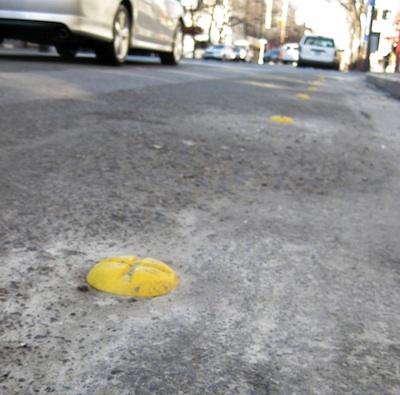
New York City took a significant step today toward modernizing the way it allocates scarce curbside parking spaces, but it remains to be seen whether the city will embrace the full potential its new parking tech.
At a press conference in the Belmont neighborhood of the Bronx this morning, Transportation Commissioner Janette Sadik-Khan and City Council Transportation Committee Chair James Vacca announced the installation of 177 parking sensors. Using magnets, the sensors can detect not only the presence of a vehicle, but the moment individual cars enter or leave spaces and the "magnetic signature" of individual vehicles. The sensors can be linked to parking meters and to enforcement officers in real-time.
The city hopes to use this batch of sensors to test out a smartphone app showing drivers how many on-street spaces are open on a given block. But more transformative changes like using the sensors to rationalize parking pricing, as in San Francisco, or to beef up parking enforcement as is common in Europe, aren't yet in the works for New York City.
For the next three months, the city will just be checking to see whether the sensors can stand up to "the rigors of the streets of New York," said Sadik-Khan, including inclement weather and street-sweeping.
If the sensors are tough enough, the city expects to unveil its parking app sometime around April. For a given stretch of spaces, the app will tell drivers whether there are fewer than two spaces available, two to three, or four or more. "We're making it easier for drivers to park," said Sadik-Khan. Neither the parking regulations in the area nor parking enforcement will change, she said.

Vacca applauded the efforts to make parking easier. "We want people to come to Arthur Avenue," he said, referring to the nearby Italian commercial corridor. "When you can't get that parking space, you want to turn around and go back where you came from."
Other cities around the world use parking sensors to do far more than lead drivers to an open space, however. San Francisco's SFPark program, for example, uses similar technology to price on-street parking in line with demand: Parking rates are raised or lowered to ensure there's usually one space open per block. Los Angeles's ExpressPark system, launching this spring, will add enforcement into the mix, using the sensors to guide traffic officers to the areas where they'll be most needed. In Paris, both traffic enforcement officers and drivers receive a text message when their meter has expired, a policy that the Institute for Transportation and Development Policy identified as helping reduce the use of private automobiles there.
New York has its own program, called ParkSmart, to align curbside parking prices with demand, and the city has shown interest in the full range of applications for parking sensors. When the Bloomberg administration notified companies in 2010 that the city was interested in next-generation parking tech, DOT hoped to not only use sensors for dynamic pricing and enforcing meter violations, but to crack down on placard abuse as well. And last November, Sadik-Khan told a tech conference that New York City's smart parking technology would be used to manage the price of parking. But it's not clear from today's announcement whether data from the new sensors will be used to help set meter rates.
When asked whether those functions were still being pursued, Sadik-Khan said, "That's not the intention right now." She did say that once the city had parking data reliably coming in, there will be "all sorts of opportunities."
The pilot project was paid for entirely by three vendors potentially interested in bidding on a larger project: Streetline, ACS, and IPsens. The sensors, which go two to a space, cost $250 each, though the city would likely get a bulk discount if it pursued a large-scale implementation.





